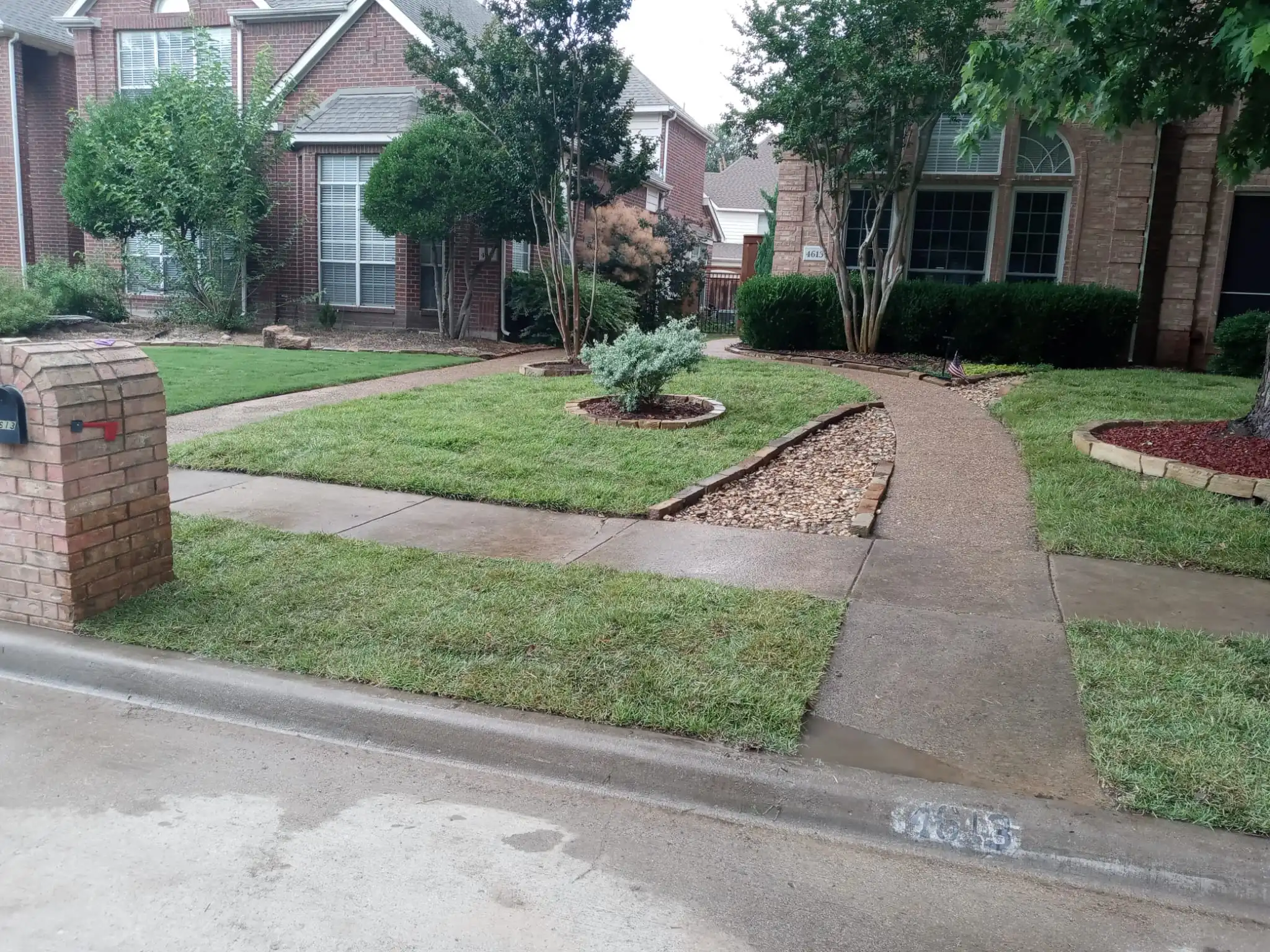As August approaches, so do scorching heat domes, putting your lawn at risk of wilting under the relentless sun.
Watering your lawn becomes paramount to its survival, but how you water it makes all the difference. Embracing deep watering for lawns in August is critical to a resilient yard that survives heat waves.
For example, when watering, resist the urge to sprinkle lightly every day; instead, water deeply and less frequently. This technique encourages deep turfgrass root growth, allowing the roots to reach deeper into the soil, where they can tap into moisture during scorching days.
Prepare your lawn now, and it will thank you with its vibrancy even during the hottest days of August.
Understanding August’s Heat Impact on Your Lawn
Whether it’s a heat dome or a prolonged heat wave that doesn’t let up, the sun stresses your lawn, especially in August when temperatures can soar into the upper 90s and the 100s.
While warm season grasses are drought-resistant and heat-tolerant, they still suffer from heat stress. Fortunately, Bermuda and St. Augustine grasses found on many Richardson and Murphy, TX lawns grow so densely that they can handle the hot, long August days by shading the soil to keep it cooler.
Learn more: Benefits of Full-Service Lawn Care in North Texas
However, you’re adding to your turf’s stress if you don’t practice smart watering techniques, such as watering your Collin County, TX lawn before 10 a.m.
How can you tell if your lawn is heat stressed? Here are the signs to look for:
- Your lawn is crunchy
- Your footprints stay on the grass
- Your lawn’s color looks blue-gray or silver
- Turfgrass blades curl.
While Bermuda is drought tolerant, it isn’t immune to heat stress. The same is true for St. Augustine. However, St. Augustine grass is only drought-tolerant in the shade—not in full sun, according to AustinTexas.gov’s “Lawn Problems.”
Finally, you want your turfgrass to grow deep roots that help the turf find underground moisture stores and help the grass stay resilient during the extreme summer heat.
Mastering Deep Watering for Lawns in August
In our July blog, The Ultimate Guide to Watering Your North Dallas Lawn This Summer, we talked about the benefits of the cycle-and-soak method: running your lawn’s sprinkler system for 15 minutes and then taking a break so water can percolate into the soil.
If you have Wi-Fi and Bluetooth connections on your in-ground sprinkler system, set the timer to turn on the irrigation for 15 minutes, then turn it off and on for two to three cycles.
You don’t want to run your irrigation system for 30 minutes or more straight without a break because water won’t be absorbed into the ground and will run into the street and stormwater drains.
Worried that your lawn isn’t getting enough water deep in the soil? Then use a screwdriver or a soil probe to measure. You want 4”–6” of moisture absorbing into the ground. When you get to 4”, stop irrigating your lawn.
How In-Ground Lawn Sprinkler Systems Use Smart Irrigation Technology to Optimize Water Usage
Today’s lawn sprinkler systems can hook up with Wi-Fi and Bluetooth so that you can manage your irrigation system at home or the office.
If you have an older sprinkler system, you can have your system updated to include moisture and weather sensors.
Technology helps you to conserve water and save money on your utility bills. If you add a moisture sensor, your water sprinkler will stop when the soil has 4” to 6” of moisture.
Likewise, you can add weather sensors that turn off your irrigation system when it’s beginning to rain or if the temperature drops to freezing.
If you invest in a new irrigation system, you can get these sensors to help you conserve water, stay compliant with North Dallas watering restrictions, and ultimately save you money.
Other Factors Affecting Water Absorption and Retention
Homeowners in Murphy, Sachse, Frisco, and the rest of Collin County, TX have clay, loamy, or sandy soils; you need to know how to improve the ground to retain more moisture.
Ideally, you want loamy soil because it holds water and is aerated, meaning oxygen flows through the ground. Clay soil will hold in moisture longer too, but it takes a lot of water to get through compacted soil.
If you have sandy soil, the water will pass through quickly without retaining much moisture underground.
Consider making an appointment for liquid aeration to break up compacted soil in September. If you have sandy soil, you want your lawn care company to add amendments to make it loamier.
Avoid These Common Watering Mistakes
We’ve all made mistakes watering our lawns in Collin County, TX. And to benefit our turfgrass, we must change how we irrigate our yards.
Read more: Liquid Lawn Aeration: A Breakthrough in Lawn Care
Do you make the following watering mistakes?
- Water your lawn in the evening
If you water later in the evening, the grass blades will be wet overnight and pick up a fungal disease, such as gray leaf spot, rust, or large patch. Instead, set your irrigation system’s timer to go off early, from 3 a.m. to 9 a.m.
- Set your sprinkler system to start watering during the hottest part of the day
If you set your sprinkler system to go off in the middle of the afternoon, when it’s the hottest, you’ll be wasting water because it’ll evaporate and not penetrate the soil.
- Avoid getting moisture or weather sensors added to your lawn sprinkler
However, if you want a healthy, vibrant lawn throughout August, you’ll be wise to add those sensors to your lawn sprinkler.
- Not adjusting spray heads which water the driveway and sidewalks rather than the turfgrass
Again, you’re wasting water when your sprinkler heads aren’t overlapping your lawn. Since water is a premium in North Dallas, you must check your sprinkler heads to ensure they work efficiently.
- Water your lawn every day for a few minutes
If you want your lawn to have shallow roots and die when heat-stressed, you’ll do a daily sprinkle.
However, if you want to keep your turfgrass healthy and survive heat stress, you’ll practice deep watering for lawns in August, and only water your lawn 1 to 2 times a week.
How College Fund Landscaping Gets Your Lawn Ready for August
Save your lawn this August by following these smart watering tips. Then make an appointment with us at College Fund Landscaping to apply liquid aeration to the soil in September to relieve soil compaction.
Have questions about your lawn and its watering needs? Contact us today at 972-985-0279 or fill out our contact form.
Sources:
AggieTurf.Tamu.edu, St. Augustinegrass Lawn Management.
AustinTexas.gov, Earth-Wise Guide to Lawn Problems.
Extension.OKState.edu, Smart Irrigation Technology: Controllers and Sensors.
NatureHills.com, What are Warm Season and Cool Season Grasses?
NBCDFW.com, Keeping Your Lawn Looking Good in the Heat.
PlantDiseaseHandbook.Tamu.edu, Bermudagrass.
SouthernLiving.com, Lawn Watering Mistakes We All Make.



Comments (0)
Thanks for your comment!
Thanks for your feedback! Your comments have been successfully submitted! Please note, all comments require admin approval prior to display.
Error submitting comment!
There is a problem with your comment, please see below and try again.